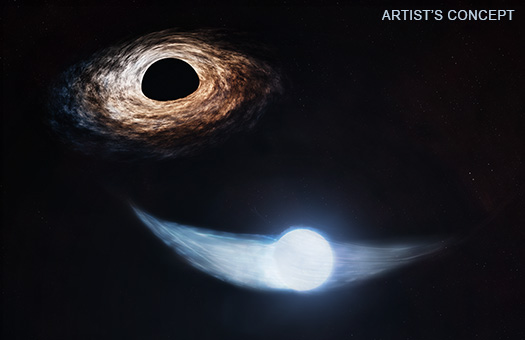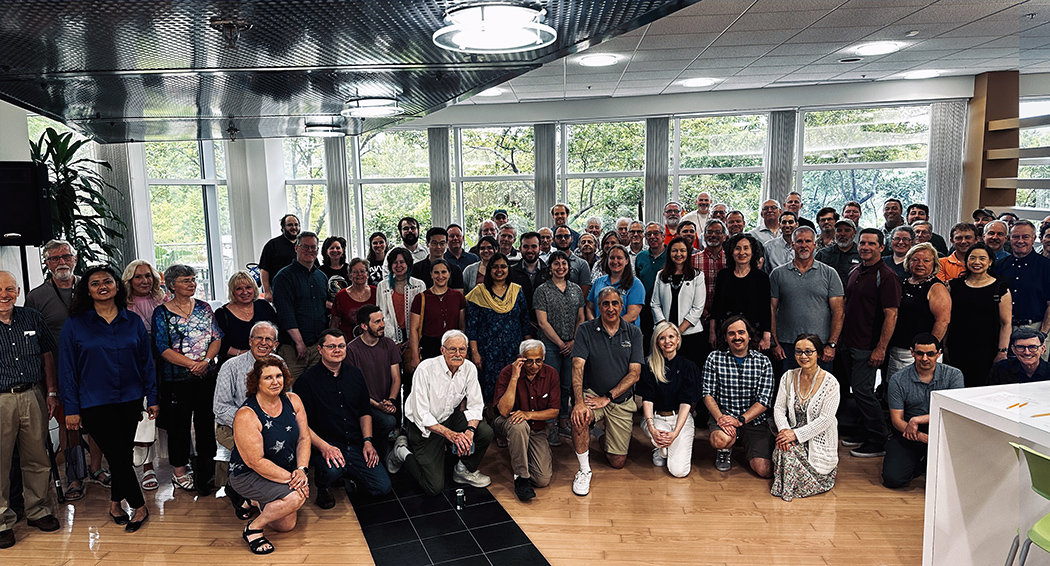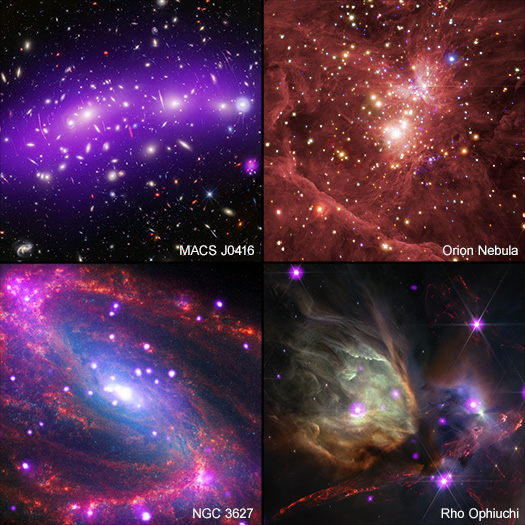Chandra Teams Up Again With Astrophotographers
Messier 106 (M106), also known as NGC 4258, is a spiral galaxy – like our own Milky Way -- located in the constellation Canes Venatici. It lies at a distance of roughly 23 million light-years and spans some 135,000 light-years in diameter.
This galaxy is famous, however, for something that our Galaxy doesn’t have – two extra spiral arms that glow in X-ray, optical, and radio light. These features, called anomalous arms, are not aligned with the plane of the galaxy, but instead intersect with it. The X-ray image from Chandra reveals huge bubbles of hot gas above and below the plane of the galaxy. These bubbles indicate that much of the gas that was originally in the disk of the galaxy has been heated to millions of degrees and ejected into the outer regions by the jets from a supermassive black hole at the galaxy’s core.
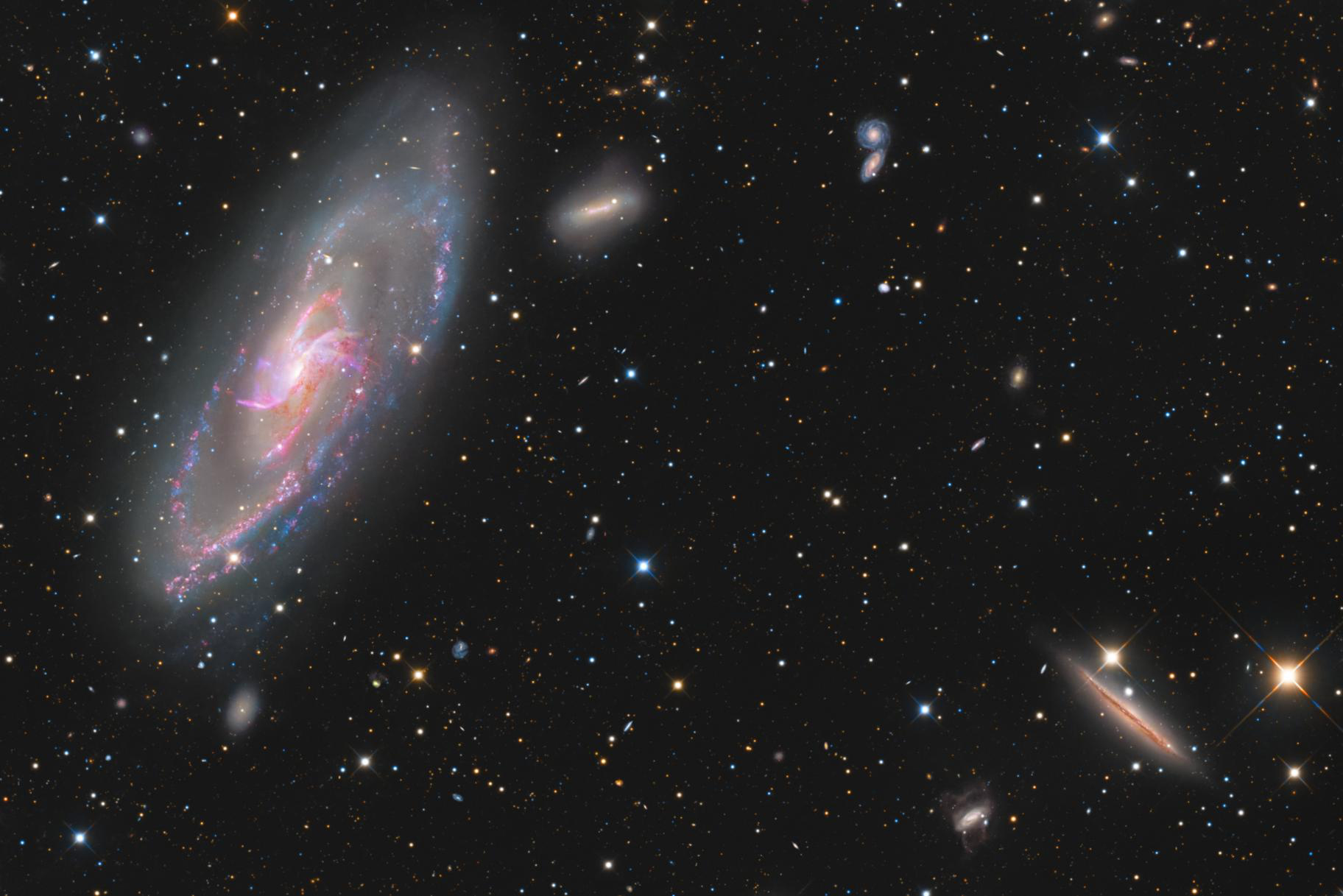
Credit: Optical: Deep Sky Collective; Chandra X-ray (purple): NASA/CXC/SAO;
VLA Radio (yellow): NSF/NRAO/VLA; Spitzer IR (Red): NASA/JPL-Caltech
It's not only space-based X-ray telescopes like Chandra, however, that have looked at M106. Excellent work has been done from the ground including by amateur astrophotographers including a group called the Deep Sky Collective (DSC). The DSC, founded by Tim Schaeffer in 2023, aims to use the group’s telescopes in a concerted way to explore some of the faintest and most difficult target in the sky in great detail.
Chandra Shows Off its "Scrollytelling"
The Chandra team has been working behind the scenes with the Smithsonian Institution's Digitization 3D Program, to create a new scrolling interactive for Cassiopeia A.
The term "scrollytelling" is real, even if you might not find it in every dictionary. (Though if you look in online ones – especially any that include online terminology – you will.) You may have experienced scrollytelling yourself if you’ve read or explored longer pieces of content on certain platforms or news outlets.
The idea is simple: as you scroll down the page, new information in the form of text, images, and videos will appear. It’s an effective way to convey layers of information, and we’re excited to share this new resource that will let you explore Cassiopeia A in a new way! Cas A, as it’s known, is arguably Chandra's most famous data of a supernova remnant, the leftover material from a star that exploded 340 years ago. Chandra has observed Cas A many times over its 25-year mission, and we have discovered lots about this exploded star -- including how it looks in three dimensions.
Seeing Chandra… From the Ground
It’s been over a quarter of a century since the Space Shuttle Columbia deployed NASA’s Chandra X-ray Observatory into space during mission STS-93. Chandra’s highly elliptical orbit takes it over one-third of the distance to the Moon at its farthest point.

Although Chandra's closest approach to Earth fluctuates extensively with long-term variations in the orbit, it is still typically well more than 600 miles (1000 kilometers) above the surface. Compare that to the International Space Station which orbits our planet at an altitude of about 250 miles, and the Hubble Space Telescope which sits about 320 miles above Earth. It’s clear that Chandra is rather far away from us.
New NASA Sonifications Listen to the Universe's Past
Your browser does not support the video tag.
Cassiopeia A Sonification
Credit: X-ray: NASA/CXC/SAO; Optical: NASA/ESA/STScI; IR: NASA/ESA/CSA/STScI/Milisavljevic et al., NASA/JPL/CalTech; Image Processing: NASA/CXC/SAO/J. Schmidt and K. Arcand; Sonification: NASA/CXC/SAO/K.Arcand, SYSTEM Sounds (M. Russo, A. Santaguida)
A quarter of a century ago, NASA released the “first light” images from the agency’s Chandra X-ray Observatory. This introduction to the world of Chandra’s high-resolution X-ray imaging capabilities included an unprecedented view of Cassiopeia A, the remains of an exploded star located about 11,000 light-years from Earth. Over the years, Chandra’s views of Cassiopeia A have become some of the telescope’s best-known images.
To mark the anniversary of this milestone, new sonifications of three images — including Cassiopeia A (Cas A) — are being released. Sonification is a process that translates astronomical data into sound, similar to how digital data are more routinely turned into images. This translation process preserves the science of the data from its original digital state but provides an alternative pathway to experiencing the data.
CfA Celebrates Chandra’s 25th Anniversary
Twenty-five years ago, the Space Shuttle Columbia launched into space carrying the Chandra X-ray Observatory. Press releases from the Chandra X-ray Center, CfA, and Smithsonian shared 25 new images with Chandra data to publicize this momentous milestone. A dedicated webpage to Chandra’s 25th birthday, plus the new images and press release, can be found at https://chandra.si.edu/25th/
25 Images to Celebrate NASA's Chandra 25th Anniversary
This montage contains 25 new images with data from NASA’s Chandra X-ray Observatory that is being released to commemorate the telescope’s 25th anniversary in space, as described in our latest press release. Since its launch into space on July 23, 1999, Chandra has been NASA’s flagship mission for X-ray astronomy in its fleet of “Great Observatories.” Chandra discovers exotic new phenomena and examines old mysteries, looking at objects within our own Solar System out to nearly the edge of the observable Universe.
Chandra Images on Display in Washington, DC Metro Stations
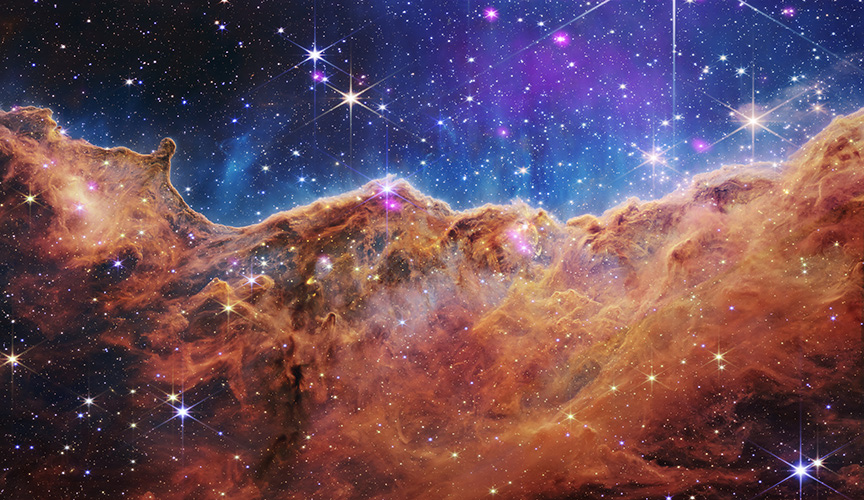
NGC 3324
(Credit: X-ray: NASA/CXC/SAO; IR (Spitzer): NASA/JPL-Caltech; IR (Webb): NASA/ESA/CSA/STScI)
If you happen to be riding the Metro subway system in Washington, DC over the next few months, take a moment to check out the video displays. On six stations, images from NASA’s Chandra X-ray Observatory will be featured as a cosmic distraction while you wait for the next train.
The Inside Story of How an Interstellar Jam Session Came to the Las Vegas Sphere
The guest blogger for this post is our own Dr. Kimberly Arcand, Visualization Lead and Emerging Technology Scientist for the Chandra X-ray Center. Kim has been working with Chandra since before the telescope’s launch and has been at the forefront of bringing Chandra data to the public in innovative ways. Some of her recent collaborations include the Chandra sonification project. In addition to being a NASA project, Chandra is also part of the Smithsonian Institution (the telescope is operated by the Smithsonian Astrophysical Observatory in Cambridge, Mass.) That connection led to a new collaboration, described below, between Kim and Mickey Hart, the Grateful Dead, and Dead and Company, drummer and artist.

Westerlund 2
Credit: NASA/CXC/SAO & NASA/STScI
There is an inherent connection between music and space. There’s no rift between science and art, just a riff. They are two sides of the same coin, more alike than different.
Take a Summer Road Trip Through Images with NASA's Chandra, Webb
It’s time to take a cosmic road trip using light as the highway and visit four stunning destinations across space. The vehicles for this space get-away are NASA’s Chandra X-ray Observatory and James Webb Space Telescope.
In each of the images, which add Chandra data to previously released Webb images, the colors represent different wavelengths of X-ray, optical, or infrared light.


